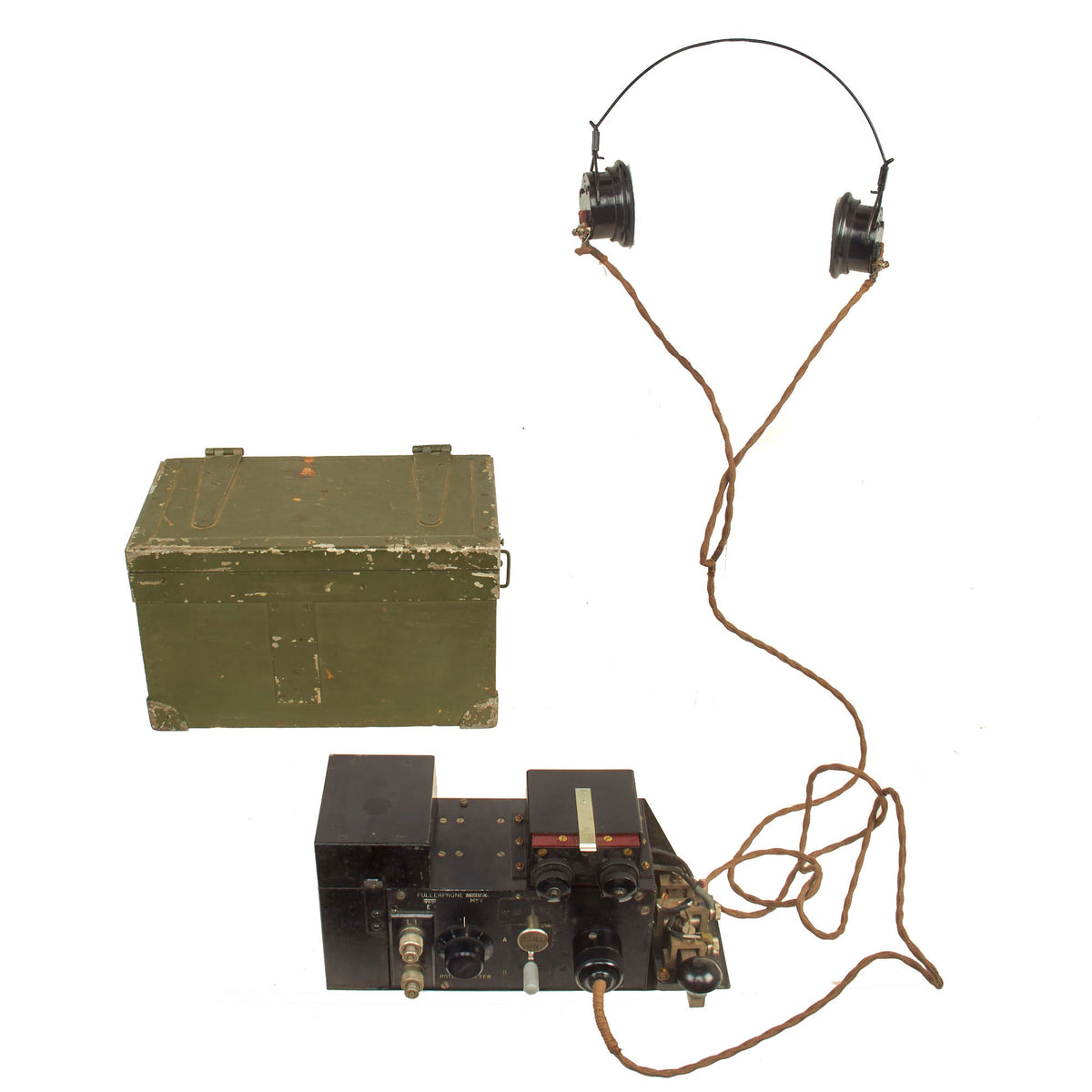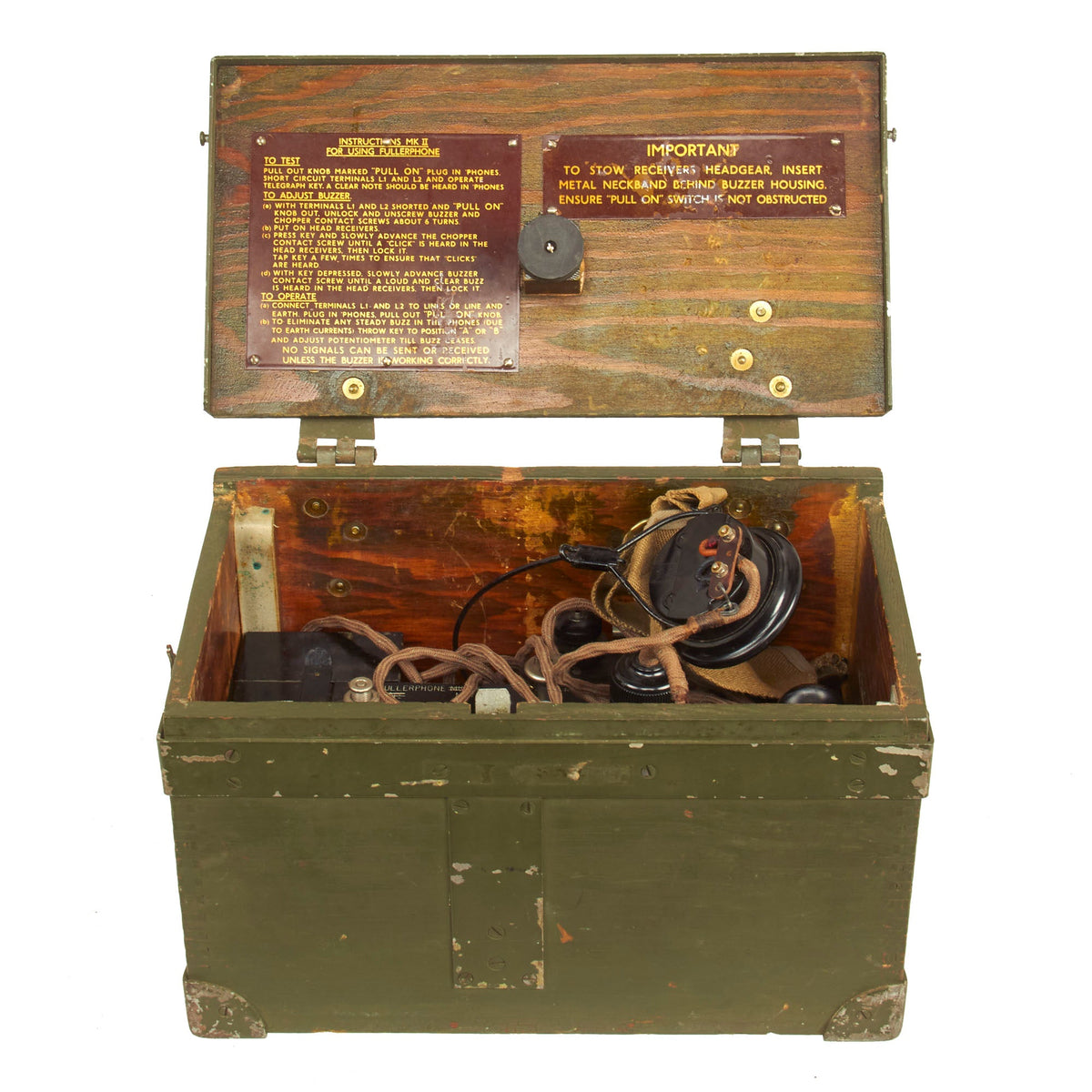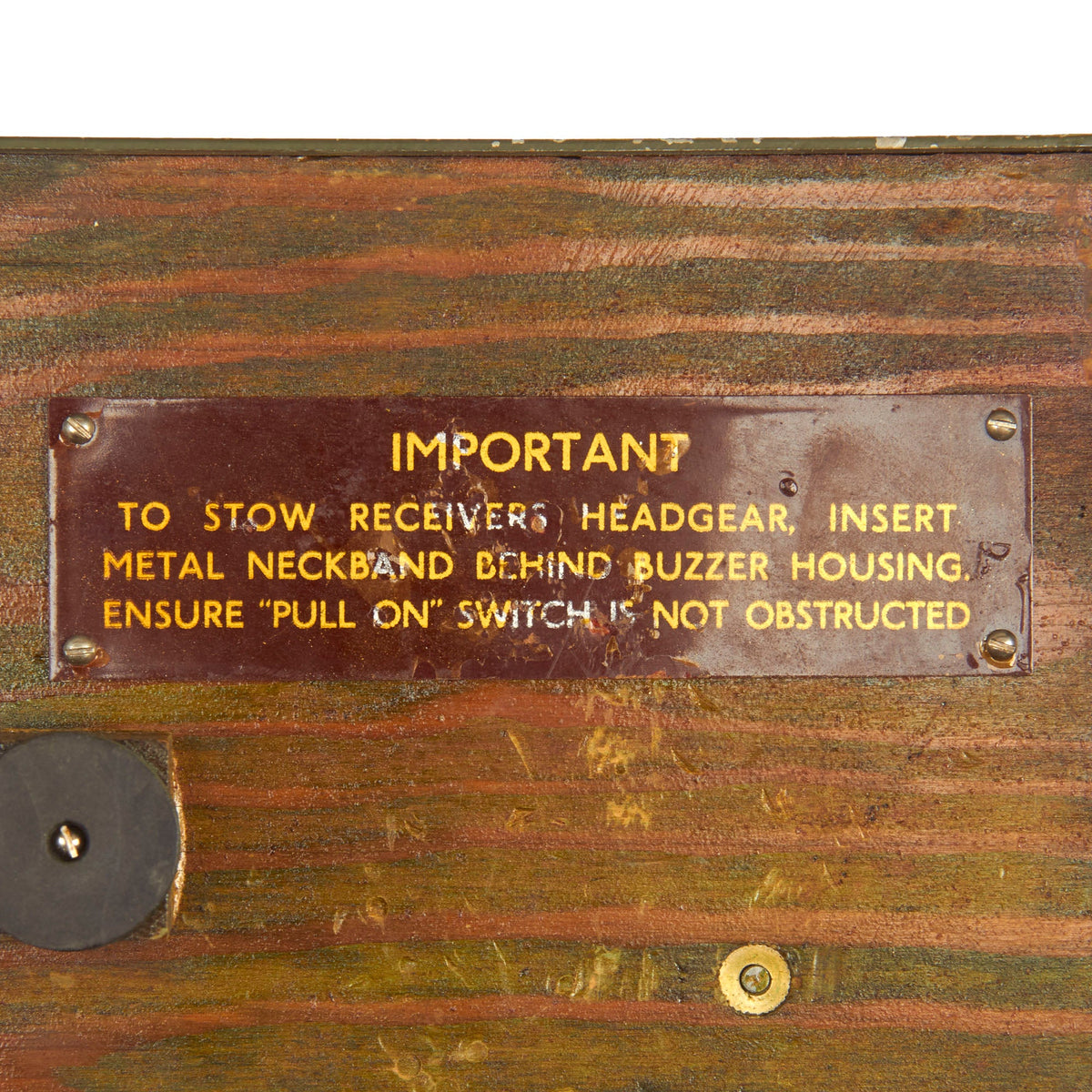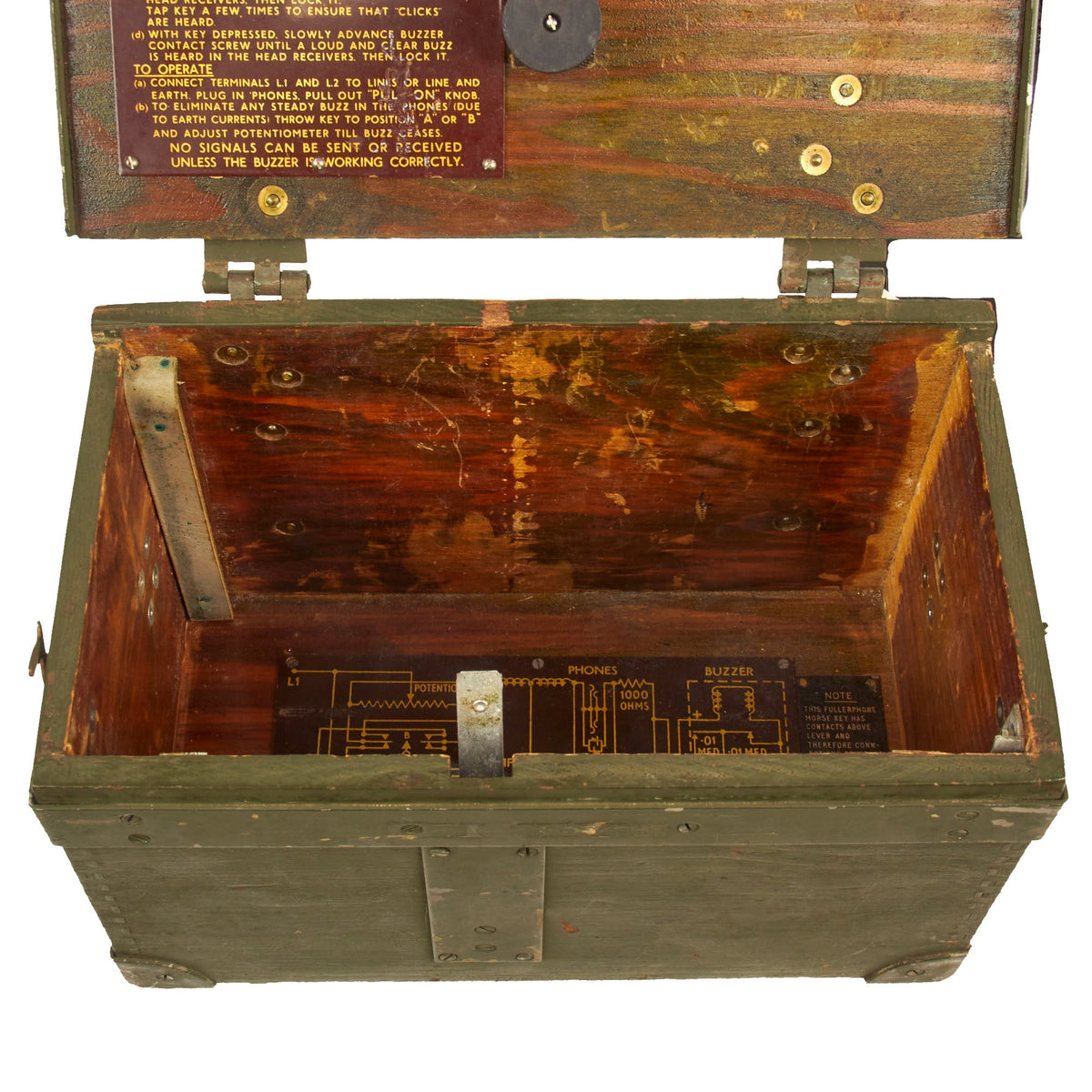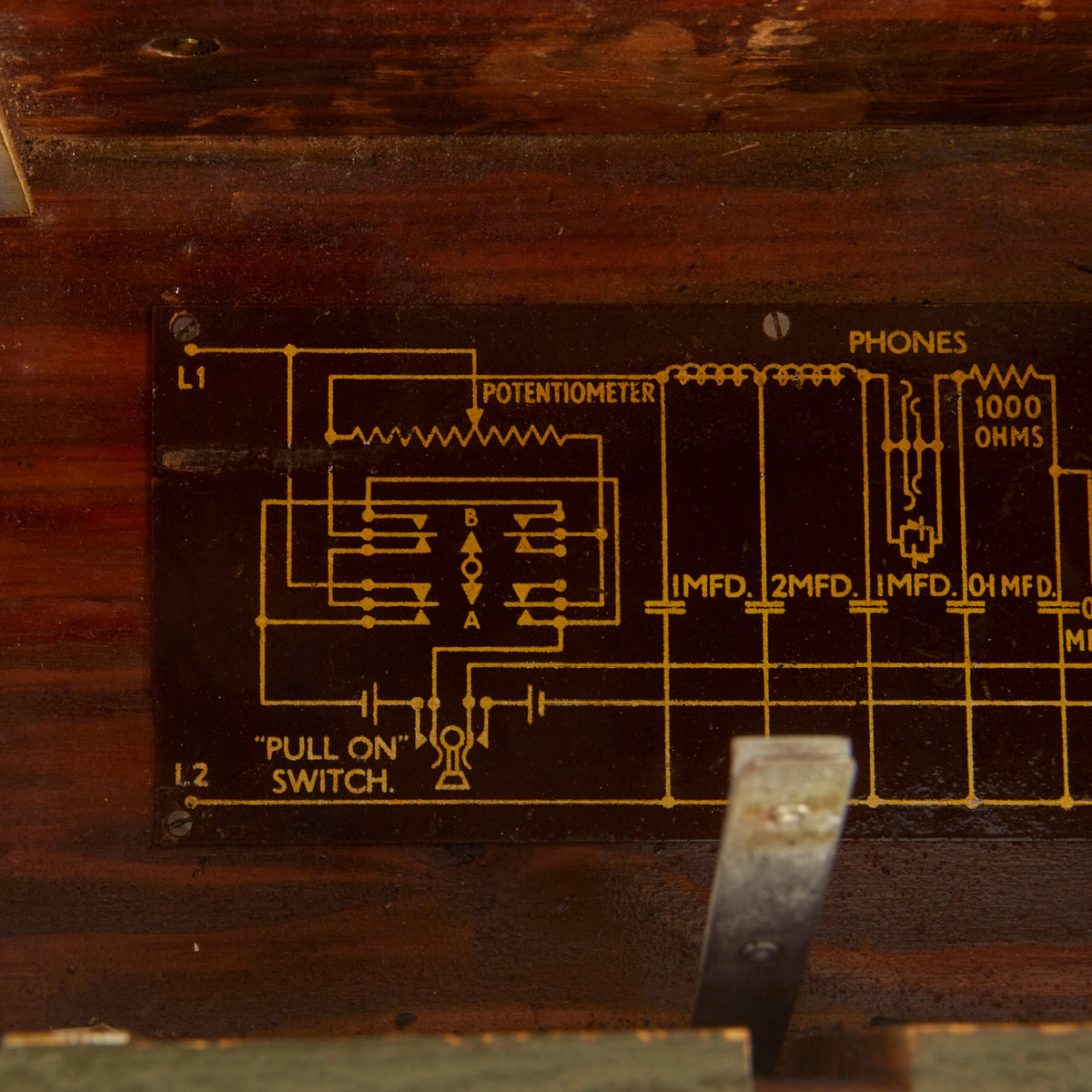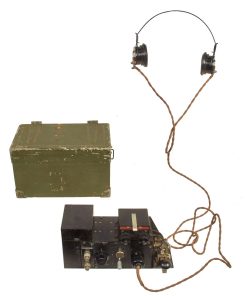Original British WWII US Issue Fullerphone Modified Mk V Portable Telegraph Signaling Device With Mk II Case Original Items
$ 395,00 $ 118,50
Original Item: Only One Available. This is a first for us here at IMA and an excellent example at that! This field phone looking device is not a phone at all but instead a Mk V Portable Telegraph Signaling “Fullerphone”. The device which was British made, is housed in an American WWII case, leading us to believe that it was used by American forces during the war.
The wooden case is still structurally sound with all hardware appearing to be present. The fullerphone itself was modified from a Mk IV to a Mk V. In 1935 the “Fullerphone Experimental” was developed, based on the Fullerphone Mk.III. It was much lighter, smaller and had a modified and replaceable buzzer. The telephone facility, which was incorporated in the Mk.III was omitted as being liable to be used in a forward area by a non-technical user, under the impression that the speech from it could not be picked up by the enemy. This experimental model evolved into the Fullerphone Mk.IV.
The headphones used with the Fullerphone were low resistance types. Three models are recorded to be issued: Receivers, headgear, CLR, double Mk.III (used with Mk.I case); Receivers, headgear, CLR, double No.3 and Receivers, headgear, DLR, double No. 5 (used with Mk.II case).
A lovely example that comes more than ready for further research and display.
Fullerphone Mk.IV, Mk.IV*, Mk.IV**, Mk.V and Mk.6.
In 1935 the “Fullerphone Experimental” was developed, based on the Fullerphone Mk.III. It was much lighter, smaller and had a modified and replaceable buzzer. The telephone facility, which was incorporated in the Mk.III was omitted as being liable to be used in a forward area by a non-technical user, under the impression that the speech from it could not be picked up by the enemy. This experimental model evolved into the Fullerphone Mk.IV.
The most commonly used Fullerphones Mk.IV, Mk.IV* and Mk.V were housed in an aluminium and steel case, secured by guides in a wooden carrying case provided with a sling.
The headphones were carried in the lid of the case (Mk.I case only) or in the Fullerphone case (Mk.II case). When the lid was completely closed, the ‘Pull-On’ switch was automatically set in the ‘Off’ position. A spring stop which kept the Fullerphone unit in position in the carrying case had to be pressed down for the unit to be drawn forward into the operating position. A second stop prevented the unit from sliding completely out of the case. The removable Buzzer F slide into position on the top right-hand side of the instrument, the connections being made by three contact springs.
The Mk.IV* was fitted with radio interference suppression and to reduce the possibility of radio interception. A crash limiter was fitted in the Mk.IV**. Mk.V models were similar to the Mk.IV** but had a tropical finish. The Morse key was a Key WT 8 Amp No. 2 which could be one of the many versions which were produced over the time. The Morse key of the Mk.V and Mk.6, however, was a Key Signalling No. 2, tropicalised, which was similar in appearance to Key W.T. 8 Amp No. 2 Mk.II. It had contacts not made from the usual Tungsten but from different material which was more suitable for tropical use. These contacts could, however, not handle 8 Amperes, hence the different name and YA class VAOS stores number.
Canada
In 1942 and 1943 Canada produced 14.000 Mk.IV and Mk.IV* Fullerphones. The instrument differed only in detail to the British parent model and was functionally and physically similar. The Morse key fitted in the later produced Canadian Fullerphones was a Canadian Key W.T. 8 Amp No. C3 which was a simplified version with two U-shaped bridges of pressed steel construction.
Fast Shipping with Professional Packaging
Thanks to our longstanding association with UPS FedEx DHL, and other major international carriers, we are able to provide a range of shipping options. Our warehouse staff is expertly trained and will wrap your products according to our exact and precise specifications. Prior to shipping, your goods will be thoroughly examined and securely secured. We ship to thousands clients each day across multiple countries. This shows how we're dedicated to be the largest retailer on the internet. Warehouses and distribution centres can be located throughout Europe as well as the USA.
Note: Orders with more than one item will be assigned a processing date depending on the item.
Before shipping before shipping, we'll conduct a thorough inspection of the items you have ordered. Today, the majority of orders will be delivered within 48 hours. The delivery time will be between 3-7 days.
Returns
The stock is dynamic and we cannot completely manage it because multiple stakeholders are involved, including our factory and warehouse. So the actual stock may alter at any time. It's possible that you may not receive your order once the order has been made.
Our policy is valid for a period of 30 days. If you don't receive the product within 30 days, we are not able to issue a refund or an exchange.
You can only return an item if it is unused and in the same state as the day you received it. You must have the item in its original packaging.
Related products
Uncategorized
Uncategorized
Uncategorized
Uncategorized
Uncategorized
Uncategorized
Uncategorized
Uncategorized
Uncategorized
Armoured Fighting Vehicles of the World: AFVs of World War One (Hardcover Book) New Made Items
Uncategorized
Uncategorized
Uncategorized
Uncategorized
Uncategorized
Armored Burgonet Helmet & Polearm from Scottish Castle Leith Hall Circa 1700 Original Items
Uncategorized
Uncategorized
Uncategorized
Uncategorized
